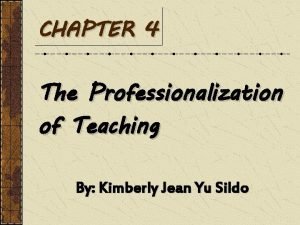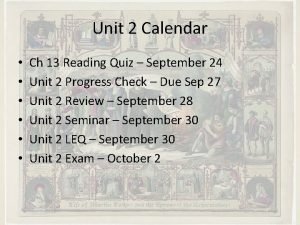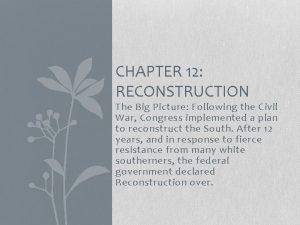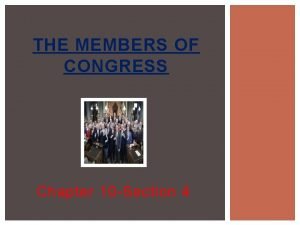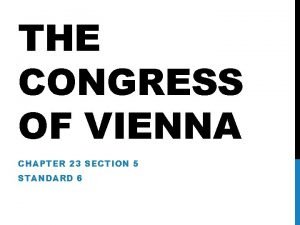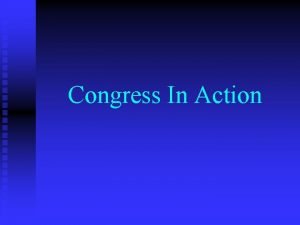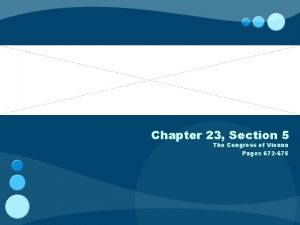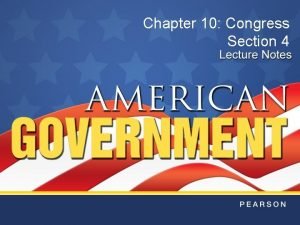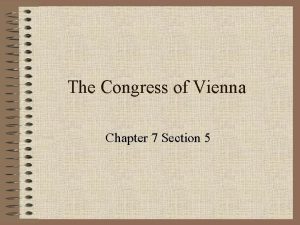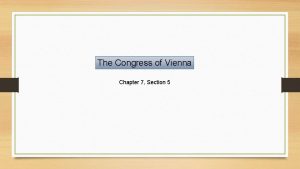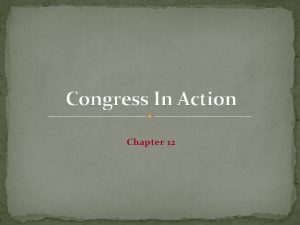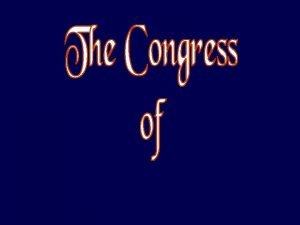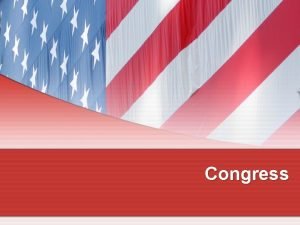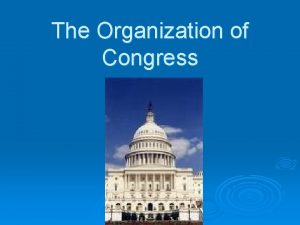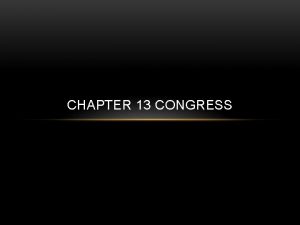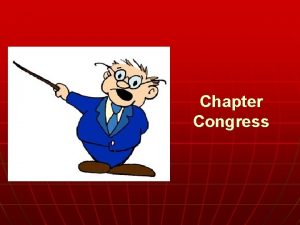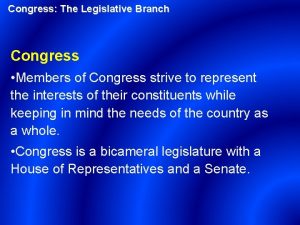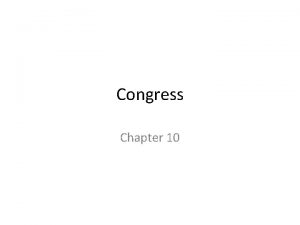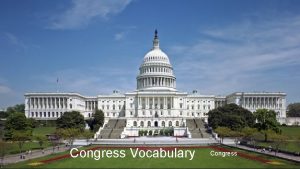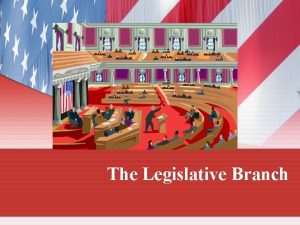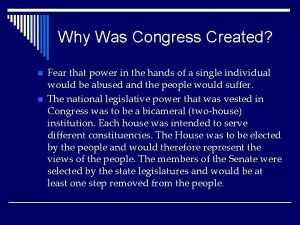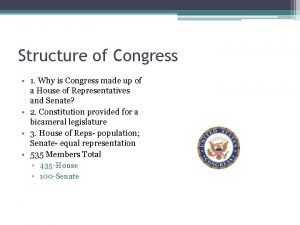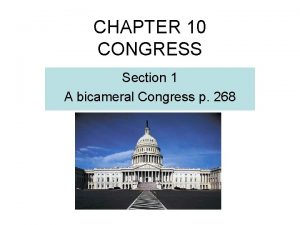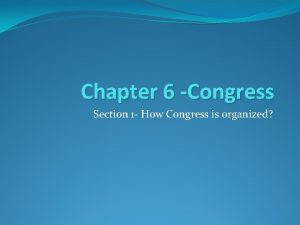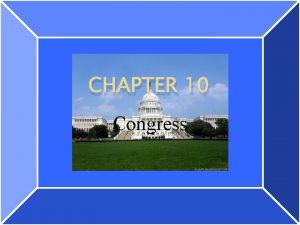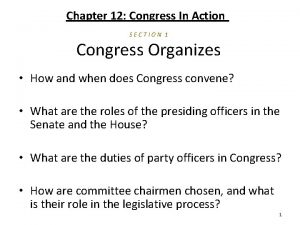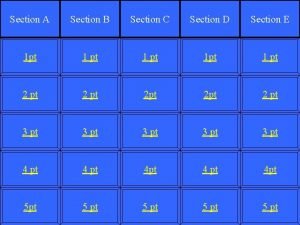Congress Section 1 Why Was Congress Created n






















- Slides: 22

Congress Section 1

Why Was Congress Created? n n n The founding fathers believed that the bulk of governmental power should be in the hands of the legislature. A bicameral format was chosen to try and balance the power between larger and smaller states. Congress’ powers include the Enumerated Powers listed in the Constitution and those afforded through the Elastic Clause.

Six Functions of Congress 1. 2. Lawmaking Function ♠Decisions about the size of the federal budget, health care reform, gun control. ♠Often use agreements called logrolling: an arrangement in which 2 or more members of congress agree in advance to support each other’s bills. Service to Constituents ♠Congressmen take part in casework: Personal work for constituents by members of Congress. (Finding missing SS check)

Six Functions of Congress 3. Representation Function There are four views on representation: 1. Trustee-one who acts according to his or her conscience. 2. Delegate-votes according to the views of his constituents. 3. Partisan-usually votes how their party votes. 4. Politico-mixture of trustee, delegate, and partisan.

Six Functions of Congress 4. Oversight Function: ♠ The responsibility Congress has for following up on laws it has enacted to ensure that they are being enforced and administered in the way Congress intended. ♠ Usually done by changing an agency’s budget after an investigation.

Six Functions of Congress 5. Public-Education Function: ♠The government has the responsibility of educating the public about the work it is doing. ♠This is done through having public hearings and floor debates. 6. Conflict-Resolution Function: ♠Congress attempts to resolve differences in points of view in American society by making decisions. ♠Laws on Gun Control, Abortion, etc.

Congress Section 2

House and Senate n n Qualifications to be in the House of Reps. : n Must be at least 25 years old. n Must have been a U. S. citizen for 7 years. n Must live in the state from which they are elected. Qualifications to be in the Senate: n Must be at least 30 years old. n Must have been a U. S. citizen for 9 years. n Must live in the state from which they are elected.

House and Senate n Differences in House and Senate: n n n Size: House (435) Senate (100) Term: House (2 years) Senate (6 years) Debate: House (1 Hour) Senate (Unlimited) Prestige: House (Less) Senate (More) Since debate in the Senate in unlimited, it has the power of a filibuster: stall tactics used to prevent the voting on a bill. (Strom Thurmond has the longest filibuster in history) n To end a filibuster, a vote of cloture must be called: vote by at least 60 senators to close debate on a bill and a vote on the bill must be made within 30 hours.

Congressional Elections Congressional elections are held on the Tuesday following the first Monday in November of even numbered years. n House elections are held every two years. n Senate elections are held every six years, but are staggered so that only 1/3 of the senators are up for reelection every two years. Why is this done? n

Congressional Elections n Cost of Elections n House ($1. 5 million) Senate ($10. 2 million) Candidates are either self-selected or chosen by a political party to run for office. n People run for different reasons: n n n Self-enjoyment Stepping stone to higher political office.

Power of Incumbency n n Incumbent: person who holds office and is trying to get reelected. Three reasons incumbents usually get reelected: Advertising 2. Credit Claiming 3. Position taking ♠Other reasons incumbents get reelected is because they have a head start on fundraising, have name recognition, party support and a past voting record. 1.

Congress Section 3

Congressional Reapportionment n n n Congressional Reapportionment is the allocation of seats in the House of Rep. to each state after each census. There is always 435 seats in the House. If after the census one state gains a seat, this means another state must lose a seat. After the census, states sometimes redraw the Congressional Districts within their states-this is called redistricting.

Redistricting n n n Redistricting can sometimes lead to gerrymandering: the drawing of legislative boundary lines for the purpose of obtaining a partisan or factional advantage. Named after Elbridge Gerry in 1812. The Supreme Court has ruled that redistricting for the political benefit of one group can be challenged on constitutional grounds.

Redistricting n n n In the early 1990’s, the federal government encouraged a type of gerrymandering that made possible the election of a minority representative from a “minority-majority” area. In short, they created an area where a minority group would be in the majority in order to ensure a minority candidate would be chosen. Many of these districts were challenged in court. In 1995, the Supreme Court said that they were unconstitutional when drawn on the basis of race.

Pay, Perks, and Privileges. n n U. S. Congressman are paid an annual salary of about $174, 000. They also receive other benefits: n n n n Free gym memberships Free parking Free or cheap medical care Cheap retirement plans Travel allowances Free postage to their constituents. Provided with an office staff Are immune under the law from parking tickets if in session and cannot be sued for slander or libel in government work.

Congress Section 4

The Committee Structure Most of the work in Congress is done in committees. n Committees are often called the “Little Legislature”. n Congressmen must serve on at least two committees. n

The Committee Structure n 1. Types of Committees in Congress: Standing Committee: a permanent committee in the House or Senate that considers bills within a certain subject are. -Most important are Appropriations, Ways and Means, Education and the Workforce, and Foreign Relations. 2. Select Committee: a temporary legislative committee established for a limited time period for a specified purpose.

Types of Committees in Congress 3. Joint Committee: committee made up of members from both the House and Senate. 4. Conference Committee: special joint committee appointed to iron out any differences on bills. 5. House Rules Committee -Seats on Committees are usually given based on a seniority system.

Leadership in Congress n n Leadership in the House 1. Speaker of the House-John A. Boehner 2. Majority Leader-Eric Cantor 3. Majority Whip-Kevin Mc. Carthy 4. Minority Leader-Nancy Pelosi 5. Minority Whip-Steny Hoyer Leadership in the Senate 1. President of the Senate-Joe Biden 2. President Pro Tempore-Patrick Leahy 3. Majority Leader-Harry Reid 4. Majority Whip-Richard Durbin 5. Minority Leader-Mitch Mc. Connell 6. Minority Whip-John Cornyn
 Pictures
Pictures Don't ask why why why
Don't ask why why why Why was the truman doctrine created
Why was the truman doctrine created Ra 9293 summary
Ra 9293 summary Why was it created
Why was it created Neolithic plastered skull from jericho why was it created
Neolithic plastered skull from jericho why was it created Why was nato created?
Why was nato created? Sir degore
Sir degore Why did johnson and congress clash over reconstruction
Why did johnson and congress clash over reconstruction Pearland.instructure
Pearland.instructure Chapter 10 section 4 the members of congress
Chapter 10 section 4 the members of congress Chapter 23 section 5 the congress of vienna
Chapter 23 section 5 the congress of vienna Chapter 12 section 1 congress organizes
Chapter 12 section 1 congress organizes Chapter 23 section 5 the congress of vienna answer key
Chapter 23 section 5 the congress of vienna answer key Chapter 10 section 4 the members of congress answer key
Chapter 10 section 4 the members of congress answer key Chapter 7 section 5 the congress of vienna
Chapter 7 section 5 the congress of vienna The congress of vienna chapter 7 section 5
The congress of vienna chapter 7 section 5 Chapter 12 congress organizes
Chapter 12 congress organizes Chapter 23 section 5 the congress of vienna
Chapter 23 section 5 the congress of vienna Chapter 23 section 5 the congress of vienna
Chapter 23 section 5 the congress of vienna Why-why analysis
Why-why analysis Wh tongue twisters
Wh tongue twisters Does this table represent a function why or why not
Does this table represent a function why or why not



